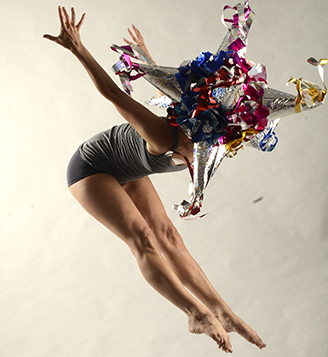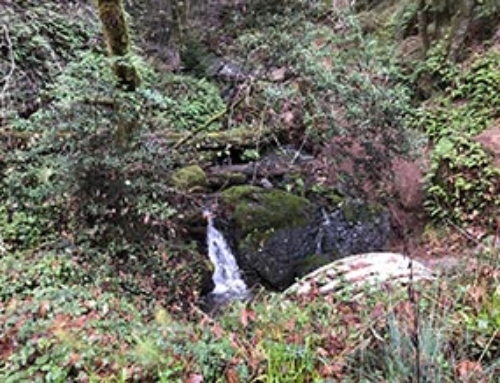[vc_row][vc_column width=”2/3″][vc_column_text]
Article by Liz Duran Boubion MFA, RSMT
As the artistic director of the Piñata Dance Collective, the first few years presenting the only Festival of Latin American Contemporary Choreographers (FLACC) in the U.S. felt like I was balancing a huge bowl of fruit on my head while wearing my big sister’s party dress that was falling off my shoulders and tripping me up everywhere I went. Each piece of fruit in the bowl was a different job description as artistic director, executive director, choreographer, curator, performer, publicist, accountant, production manager, fundraiser, stage manager, volunteer coordinator and more. The reason for this was because there was no funding and I had very little experience as a producer.
I was and still am, an artist and anarchist getting on-the job training learning to define my leadership role in FLACC while gaining knowledge about how to grow an arts organization that operates under the demands of deadlines, budgets, lists and plans. Ironically, as the baby of my Mexican-American family of 9, I was used to wearing hand-me-downs and asking people for help. So, I asked everyone I knew in the Bay Area how we should create FLACC together. I asked them how, when, where, who and why FLACC should, could and would become what it is today. While I was awkwardly pinning up my too big flouncy FLACCista party dress, my friends, new and old, were impressively catching the fruits as they fell.[/vc_column_text][/vc_column][vc_column width=”1/3″][vc_single_image image=”24426″ img_size=”full”][/vc_column][/vc_row][vc_row][vc_column][vc_single_image image=”24432″ img_size=”full” alignment=”center”][vc_column_text]I offered all the things that accompany a mixed race, Chicana, queer, female, choreographer, somatic therapist, dance teacher and single mother. I am a bridge between several worlds but I also felt that I didn’t have access to funding resources nor to the communities I identified with in the way that other dancers and Latinxs did in the Bay Area. It turned out that my own need for acceptance and sustainability was shared by many other marginalized Latinx choreographers. In many cases, the need is much greater than my own given the political climate for 1st and migrant generation Latinxs and their families. As a 2nd generation Chicana, who didn’t speak Spanish very well, I had to quickly grow into that dress and get some help carrying the big bowl of fruit.
Eric Garcia, Zari Leon, Cathy Davalos, Diana Lara, Natta Haotzima, Rogelio Lopez, our guest artists from Guadalajara, ALARIETE, and myself, were the founding choreographers in 2014 who helped create the identity for FLACC that was inherently intersectional and international. As a collective, “Latinidad” became the subject of our conversations along with who was invited and how FLACC could amplify Latinx representation on concert stages contributing to a new emergence of hybrid dance genres. Several artists associated with FLACC (Ernesto Sopprani, Karla Quintero, David Herrera, Andreina Maldonado, Caleb Luna, Rosa Rodriguez, Violeta Luna, Javier Fresquez, Sabrina Castillo, Juan Manuel Aldape Muñoz, Zoe Klein, Rulan Tangen and others) continue to push the conversation forward and we are finding that the FLACC dress can be altered and changed as we grow.[/vc_column_text][vc_single_image image=”24435″ img_size=”full” alignment=”center”][vc_column_text]Now in its 5th year, through performances, panel discussions, and artist-to-artist feedback processes, FLACC 2018 is offering opportunities to create new relationships that connect and nurture a healthy and inclusive community. FLACC encourages Latinx artists to access multiple dance styles, take innovative risks, and speak in their native tongues to an audience and organization that understands and receives them. Among the 50 pieces showcased in the last 5 years, artists have presented work along a broad spectrum of themes and explorations, including: citizenship, forced separation, treaty rights, queer and indigenous intersections, religious oppression, language oppression, re-interpreted Latino traditions, site specific dance, Chicana feminisms, environmental themes, international adoption and more.
Now, with my co-director, Juan Manuel Aldape Muñoz and our newly established Fiscal Sponsorship with Dancers Group, we are gaining balance, visibility and growing stronger. It is only 5 years in the making and we have gained the support of San Francisco Arts Commission, Zellerbach Family Foundation, California Arts Commission and individual donors. We have received funding to hire a consultant to create a strategic plan that will continue to include the input of FLACC alumni and other supportive voices of our community.[/vc_column_text][vc_row_inner][vc_column_inner width=”2/3″][vc_column_text]Our short term goals are not only to increase the length of our festival and raise artist stipends, but also to bring back our teaching series that highlights visiting artists, further develop our work-in-progress showings which brings artists out of isolation, and create an online archive platform for research and study. Ultimately, we strive to become the premier venue for Latinx and Indigenous contemporary choreographers internationally.
This year’s curatorial theme: BREAK(through) is a metaphorical concept that I have been deconstructing under the symbolism of a Piñata ritual for the last 7 years (create, destroy, regenerate). As well, it is Juan Manuel’s co-curatorial contribution to construct, build, and assemble shattered pieces that have existed to keep Latin American and indigenous contemporary choreographers out of funding pools or out of community building practices in the bay area and beyond.[/vc_column_text][/vc_column_inner][vc_column_inner width=”1/3″][vc_single_image image=”24438″ img_size=”full” alignment=”right”][/vc_column_inner][/vc_row_inner][vc_row_inner][vc_column_inner width=”1/3″][vc_single_image image=”24439″ img_size=”full”][/vc_column_inner][vc_column_inner width=”2/3″][vc_column_text]FLACC’s three-day festival will include 9 featured artists at Dance Mission Theater in the Mission district of San Francisco, beginning with Adrian Arias(Peru/US), who will be breaking through a plastic cocoon. FLACC is featuring 5 additional local companies including: David Herrera Performance Company(US), La Mezcla/Vanessa Sanchez(US), Diana Lara(Honduras/US), Piñata Dance Collective/Liz Boubion(US), Randy Reyes(Guatemala/US); and 3 visiting companies including: Twin sisters, Marisa and Maribel Plasencia(Santa Barbara, CA), Arts & Above(Cuba/Missoula, MT) and Fabiola Guillén(MX) who is bringing a group of 7 dancers from Puebla, Mexico presenting a piece confronting the restrictions of religion and sexuality. The show will include post-show panel discussions moderated by Juan Manuel on Friday and Saturday and conclude with a 5th Annual FLACC anniversary celebration on Sunday Nov. 11 after the show.
Finally, the audience is invited to join the dialogue with FLACC choreographers in a FREE Panel Discussion on Wednesday, November 7, 2018, 4-6pm, at the Latinx Research Center in Berkeley. This event is being co-sponsored by the Performance in the Americas Working Group and the Dance Studies Working Group at UC Berkeley.
See FLACC website for full details and sign up for our Newsletter! www.flaccdanza.org
About Liz Duran Boubion, MFA, RSMT:
Liz was raised in Southern California and has been presenting work in the Bay Area since 2000. She teaches contact improv, Tamalpa Life-Art Process, motivational movement to elders with neurodegenerative diseases, and beginning ballet to youth and adults at the downtown Oakland YMCA
Dance Instructor, Choreographer, Presenter
Registered Somatic Movement Therapist and Educator
Artistic Director, Piñata Dance Collective
Founder/Artistic Director ¡FLACC! Festival of Latin American Contemporary Choreographers
www.lizboubion.org[/vc_column_text][/vc_column_inner][/vc_row_inner][/vc_column][/vc_row]


